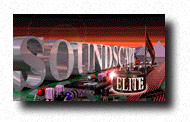Multimedia is content that uses a combination of different content forms such as text, audio, images, animations, video and interactive content. Multimedia contrasts with media that use only rudimentary computer displays such as text-only or traditional forms of printed or hand-produced material.

Digital audio is sound that has been recorded in, or converted into, digital form. In digital audio, the sound wave of the audio signal is encoded as numerical samples in continuous sequence. For example, in CD audio, samples are taken 44100 times per second each with 16 bit sample depth. Digital audio is also the name for the entire technology of sound recording and reproduction using audio signals that have been encoded in digital form. Following significant advances in digital audio technology during the 1970s, it gradually replaced analog audio technology in many areas of audio engineering and telecommunications in the 1990s and 2000s.
G.722 is an ITU-T standard 7 kHz Wideband audio codec operating at 48, 56 and 64 kbit/s. It was approved by ITU-T in November 1988. Technology of the codec is based on sub-band ADPCM (SB-ADPCM). The corresponding narrow-band codec based on the same technology is G.726.

Interactive media normally refers to products and services on digital computer-based systems which respond to the user's actions by presenting content such as text, moving image, animation, video, audio, and video games.
A container or wrapper format is a metafile format whose specification describes how different elements of data and metadata coexist in a computer file.
Digital Video Interactive (DVI) was the first multimedia desktop video standard for IBM-compatible personal computers. It enabled full-screen, full motion video, as well as stereo audio, still images, and graphics to be presented on a DOS-based desktop computer. The scope of Digital Video Interactive encompasses a file format, including a digital container format, a number of video and audio compression formats, as well as hardware associated with the file format.

The Soundscape ELITE was Ensoniq's high-end ISA PC sound card offering. It offers the highest MIDI quality of any PC sound card Ensoniq produced. The board is an evolution of the company's previous Soundscape S-2000. The Soundscape ELITE was launched in March 1995.
Sega Aurora is a highly integrated hardware platform that Sega Sammy developed to power amusement devices like their pachinko/pachislot machine displays and arcade games and to also be sublicensed to outside manufacturers who are looking to build multimedia portable and embedded systems. It was developed by SI Electronics Inc, a former Sammy subsidiary. It was introduced in 2004 and is primarily based on an enhanced Dreamcast hardware. The name "Aurora" derives from a top secret code name that Sega Enterprises, Ltd. used during the development of Sega Saturn in the mid 1990s. As SI Electronics left Sammy Holdings after being acquired by Kaga Electronics in July 1, 2008, they made the "System Board Y2" platform in 2009, mainly known for the game "King of Fighters 2002: Ultimate Match".
MPEG-4 Structured Audio is an ISO/IEC standard for describing sound. It was published as subpart 5 of MPEG-4 Part 3 in 1999.
Dialogic ADPCM or VOX is an audio file format, optimized for storing digitized voice data at a low sampling rate. VOX files are most commonly found in telephony applications, as well as an occasional arcade redemption game. It uses a lossy compression algorithm, optimized for voice, not high fidelity.

Media Vision was an American electronics manufacturer of primarily computer sound cards and CD-ROM kits, operating from 1990 to approximately 1995 in Fremont, California. Media Vision was widely known for its Pro AudioSpectrum PC sound cards—which it often bundled with CD-ROM drives—and its spectacular growth and demise.
MPEG Surround, also known as Spatial Audio Coding (SAC) is a lossy compression format for surround sound that provides a method for extending mono or stereo audio services to multi-channel audio in a backwards compatible fashion. The total bit rates used for the core and the MPEG Surround data are typically only slightly higher than the bit rates used for coding of the core. MPEG Surround adds a side-information stream to the core bit stream, containing spatial image data. Legacy stereo playback systems will ignore this side-information while players supporting MPEG Surround decoding will output the reconstructed multi-channel audio.
ACM Multimedia (ACM-MM) is the Association for Computing Machinery (ACM)'s annual conference on multimedia, sponsored by the SIGMM special interest group on multimedia in the ACM. SIGMM specializes in the field of multimedia computing, from underlying technologies to applications, theory to practice, and servers to networks to devices.
Adaptive differential pulse-code modulation (ADPCM) is a variant of differential pulse-code modulation (DPCM) that varies the size of the quantization step, to allow further reduction of the required data bandwidth for a given signal-to-noise ratio.

In digital audio data reduction technology, aptX is a family of proprietary audio codec compression algorithms owned by Qualcomm.

In signal processing, sub-band coding (SBC) is any form of transform coding that breaks a signal into a number of different frequency bands, typically by using a fast Fourier transform, and encodes each one independently. This decomposition is often the first step in data compression for audio and video signals.
Pulse-code modulation (PCM) is a method used to digitally represent sampled analog signals. It is the standard form of digital audio in computers, compact discs, digital telephony and other digital audio applications. In a PCM stream, the amplitude of the analog signal is sampled regularly at uniform intervals, and each sample is quantized to the nearest value within a range of digital steps.
WavePad Audio Editor Software is an audio and music editor for Windows and Mac. It lets users record and/or edit music, voice and other audio recordings. As an editor, users can cut, copy, paste, delete, insert, silence, and auto-trim recordings, then add effects like amplify, normalize, equalize, envelope, reverb, echo, reverse, and more with the help of VST plugin support and a free stock audio library.








